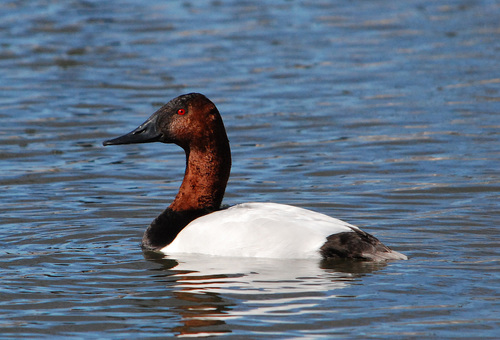
Canvasback
The Canvasback (*Aythya valisineria*) is a striking diving duck renowned for its distinctive wedge-shaped head and vibrant red eye in males. It plays a crucial role in North American wetland ecosystems, primarily as a consumer of submerged aquatic vegetation. This species holds a significant place in waterfowl hunting culture, though populations have fluctuated, demanding careful management. It is admired for its sleek appearance and rapid flight.
48-56 cm
Length
79-89 cm
Wingspan
Least Concern
Conservation Status
Distribution
Breeds primarily in the Prairie Pothole Region of North America (central Canada and north-central United States). Migrates to wintering grounds along the Atlantic and Pacific coasts of the United States, the Gulf Coast, and parts of Mexico. Some populations are resident in the Chesapeake Bay area.
Lifespan
Up to 22 years in the wild, though average lifespan is significantly shorter.
Canvasback's Habitat
Habitat Types
Freshwater marshes, Prairie potholes, Shallow lakes, Coastal bays and estuaries
Climate Zones
Temperate, Subarctic (during breeding season)
Adaptations
Specialized bill structure for straining plant material and invertebrates from water. Feet positioned far back on the body, aiding in diving but making them awkward on land.
Variations
No recognized subspecies.
Appearance
Breeding Plumage
Breeding males have a chestnut-red head and neck, black chest and rear, and a white body. Females are mottled brown overall. Non-breeding males (eclipse plumage) resemble females but retain some red on the head.
Seasonal Feather Changes
Males undergo a complete molt after breeding, adopting the eclipse plumage.
Sex Based Plumage Differences
Significant differences between males and females, especially during breeding season.
Notable Features
Distinctive sloping forehead and long, black bill., Bright red eyes in adult males., White back and sides (in breeding males) give the species its common name.
Diet and Feeding
Primary Foods
Submerged aquatic vegetation (e.g., wild celery, pondweeds), Aquatic invertebrates (e.g., insects, mollusks, crustaceans), Seeds
Foraging Behavior
Dives underwater to feed, typically in relatively shallow water (less than 2 meters). Uses its bill to strain food items from the bottom sediment or water column.
Specializations
Bill shape is adapted for feeding on submerged vegetation. The Canvasback's diet includes substantial portions of tubers, emphasizing the importance of Vallisneria americana (wild celery).
Seasonal Diet Variations
Diet shifts depending on food availability. May consume more invertebrates during the breeding season to meet protein requirements for egg production.
Behavior
Social Structure
Forms large flocks during migration and winter. Pairs form during the breeding season, and females may nest in loose colonies.
Communication
Soft quacks and croaks by females., Courtship calls by males include a 'cooing' sound., Visual displays, such as head-throws and wing-flapping.
Migration
Migrates in large flocks, often flying in V-formations. Follows established migratory corridors, with major stopover points at large lakes and wetlands.
Territorial or Group Behaviors
Males defend a small territory around the female during courtship. Females may defend the nest site from other females.
Conservation
Threats
Habitat loss and degradation (wetland drainage and pollution), Changes in water quality affecting submerged aquatic vegetation, Lead poisoning from ingestion of spent lead shot, Collision with power lines
Protection Programs
North American Waterfowl Management Plan, Wetlands Reserve Program, Conservation Reserve Program
Local National Laws
Protected under the Migratory Bird Treaty Act in the United States and Canada.
Population Trend
Fluctuating, but generally considered stable.
Population Estimates
Estimated at around 600,000-700,000 individuals.
Interesting Facts
Canvasbacks are among the fastest-flying ducks.
They have been clocked at speeds exceeding 70 mph.
The scientific name, *Aythya valisineria*, refers to the Canvasback's fondness for wild celery.
*Vallisneria americana* is a key food source for this species.
Canvasbacks are known for their 'rafting' behavior.
Large flocks often gather together in dense groups on the water.
Faqs about Canvasback
What is the difference between a Canvasback and a Redhead?
Canvasbacks have a sloping forehead and a longer, black bill, while Redheads have a rounded head and a shorter, gray bill. Male Canvasbacks have a white back, while male Redheads have a gray back.
Where can I see Canvasbacks?
Look for them on large lakes, marshes, and coastal bays during migration and winter. Key areas include the Chesapeake Bay, the Great Lakes, and the Prairie Pothole Region.
Are Canvasbacks hunted?
Yes, Canvasbacks are a popular game bird, but hunting seasons and bag limits are carefully regulated to ensure sustainable populations. Consult a professional about safety and expert advice on hunting.
Copyright @ Nature Style Limited. All Rights Reserved.
 English
English